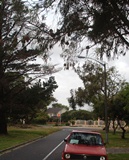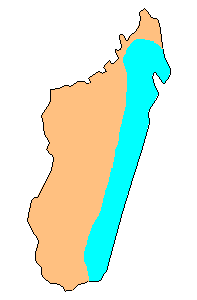Weaver news
|
The Nelicourvi Weaver Ploceus nelicourvi is endemic to forests of eastern Madagascar (see light blue on map below), based on Handbook of the Birds of the World, Vol. 15). It occurs in rainforest and secondary forest from sea level up to 1950 m, also at forest edges, in secondary habitats and village gardens near forest. The name is thought to be a Sri Lankan word (nellukurvi) for finch. There are no subspecies. The male has a black helmet, surrounded by a yellow band and grey underparts; the undertail-coverts are a conspicous rufous-chestnut (above left, from phown 179). The female resembles the male, but the black head is replaced with yellow, but with grey lores, and olive crown patch (above right, from phown 920).
The Nelicourvi Weaver feeds on insects, like beetles, bugs (Hemiptera) and grasshoppers; also spiders and possibly fruits. They regularly join mixed-species flocks of insectivorous birds. This species is monogamous, and probably has a long-term pair-bond. They are solitary breeders, with one nest, or sometimes two nests at a site but only one occupied. The nest (right, from phown 1028) has an entrance tunnel which varies in length, up to 20 cm long. The male suspends the nest above the ground, over a path or clearing, or suspended over a stream. The extent to which the sexes share incubation and feeding of the young is unknown. There are five PHOWN record for this common species (see PHOWN summary ). Submit any weaver nest records to PHOWN (PHOtos of Weaver Nests) via the Virtual Museum upload site. PHOWN summary Previous Wedn: Lesser Masked Weaver Full weaver species list |














